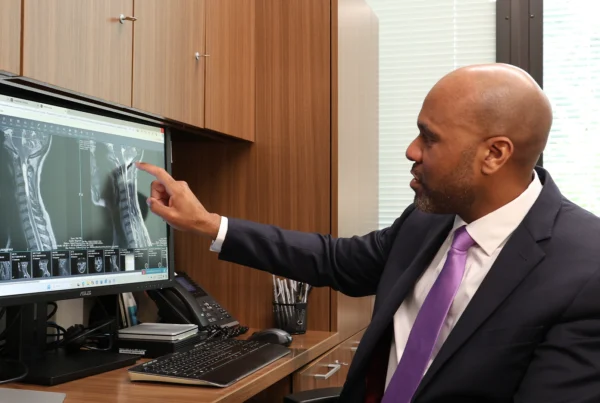When you’ve been diagnosed with trigeminal neuralgia (TGN), one of the first things you probably want to know is: how long does trigeminal neuralgia last? Many conditions may have a finite lifespan in the body, but unfortunately, trigeminal neuralgia symptoms very rarely disappear – in fact, in many instances, they get worse as time goes by. The good news is that you don’t have to suffer from the pain and other debilitating symptoms of this condition long-term. Numerous treatment options have made it possible for almost everyone with TGN to find relief.
What Is Trigeminal Neuralgia?
There are 12 pairs of cranial nerves that provide sensation throughout your head, face and neck. The trigeminal nerve is the fifth in this series, providing the majority of the sensation you experience in your face. This nerve lies basically parallel to other nerves, veins and arteries at the base of your skull. When trigeminal neuralgia strikes, it causes intense bouts of stabbing, burning or pulsing pain that are sometimes likened to a strong electrical shock.
In most cases of trigeminal neuralgia, the pain stems from one of those blood vessels lying too close or across the trigeminal nerve, causing severe irritation from the constant pounding as blood moves through. This can become progressively worse over time, making it hard to function as the nerve misfires and sends pain and other uncomfortable sensations to your face.
There are, of course, other causes for trigeminal neuralgia, including a lesion or tumor on or near the nerve, breakdown in the myelin due to multiple sclerosis or a traumatic injury that has led to nerve damage. Regardless of the cause, the results are the same: unbearable pain that robs you of your ability to participate in your normal activities.
What Can Be Done For Trigeminal Neuralgia?
There are several treatment options to consider for relieving the symptoms of your trigeminal neuralgia. Depending on the origin of your TGN and other factors such as your overall health, the cause and the location of the nerve irritation, you can expect that some treatments may be recommended over others. The top nonsurgical and surgical options are outlined so you can better understand why one may be recommended over another for your particular case.
Are you out of options
to eliminate your pain?
Medical Management
In the majority of cases, medical management will be the first step in trying to control the symptoms of TGN. Tegretol and Trileptal are the two most successfully used, but they can carry unwanted side effects. There is also the possibility that they will slowly wear off or just not work at all. In these instances, other interventions will need to be explored.
Microvascular Decompression
Microvascular decompression is the gold standard in trigeminal neuralgia treatment when it stems from a blood vessel interfering with the nerve. It offers an incredibly high success rate and some level of permanency in comparison to other treatments. It also does not interfere with nerve function, allowing those that undergo this surgery to maintain full facial sensation.
It is a procedure in which the surgeon accesses the nerve and offending vein or artery through a small “window” at the base of the skull. Using specialized microscopes and instruments, your surgeon carefully lifts the blood vessel away from the nerve, placing a tiny Teflon sponge between the two structures. This creates a cushion that absorbs the impact of the blood flow, allowing the nerve to return to its normal state. Many people find instant relief from trigeminal neuralgia pain when they undergo this surgery.
Gamma Knife Radiosurgery
If you’re not a good candidate for microvascular decompression, Gamma Knife Radiosurgery is often the next procedure that is considered. The beauty of Gamma Knife Radiosurgery is that it is completely non-invasive. It uses hundreds of tiny beams of radiation to pinpoint an area on the trigeminal nerve. When these beams converge, they create a therapeutic dose of radiation that damages or kills some of the tissue, effectively stopping the malfunctioning impulses that result in pain symptoms. Gamma Knife Radiosurgery is particularly useful in cases where an individual cannot withstand anesthesia or part of the nerve is damaged or otherwise compromised (by something other than a blood vessel).
Pain Stimulators
Another option that is less used, but still effective, is the placement of pain stimulators. These tiny electrodes are passed underneath the skin to the trigeminal nerve. When properly placed, they can deliver small pulses of electrical energy to effectively stop the abnormal nerve impulses in their tracks. Pain stimulators are minimally invasive and do not typically cause any sort of damage to the nerve.
Percutaneous Rhizotomy
One of the less-used options, percutaneous rhizotomy, involves passing an electrode to the offending area of the trigeminal nerve. A current is passed that causes minor damage to the nerve, effectively “numbing” it so that it can no longer send misfired signals to the face.
While there is no true cure for trigeminal neuralgia, it’s helpful to know that there are a number of treatments that can help you find the relief you need. So instead of asking, “How long does trigeminal neuralgia last?” you can begin asking, “What is the best course of treatment for my trigeminal neuralgia symptom relief needs?”

About Dr. Anthony D'Ambrosio
Dr. Anthony D'Ambrosio is an accomplished neurosurgeon in North Jersey and a proud member of Neurosurgeons of New Jersey practicing primarily out of their Ridgewood office conveniently located on East Ridgewood Avenue. Dr. D’Ambrosio focuses his clinical practice on brain tumors, nervous system disorders, and facial pain disorders. He has expertise in a variety of complex surgical and radiosurgical techniques as well as minimally invasive procedures intended to successfully treat complex diseases of the brain. These techniques include micro-neurosurgery, microvascular decompression surgery and Gamma Knife radiosurgery. He's authored over 25 peer-reviewed journals and is the recipient of many awards.






